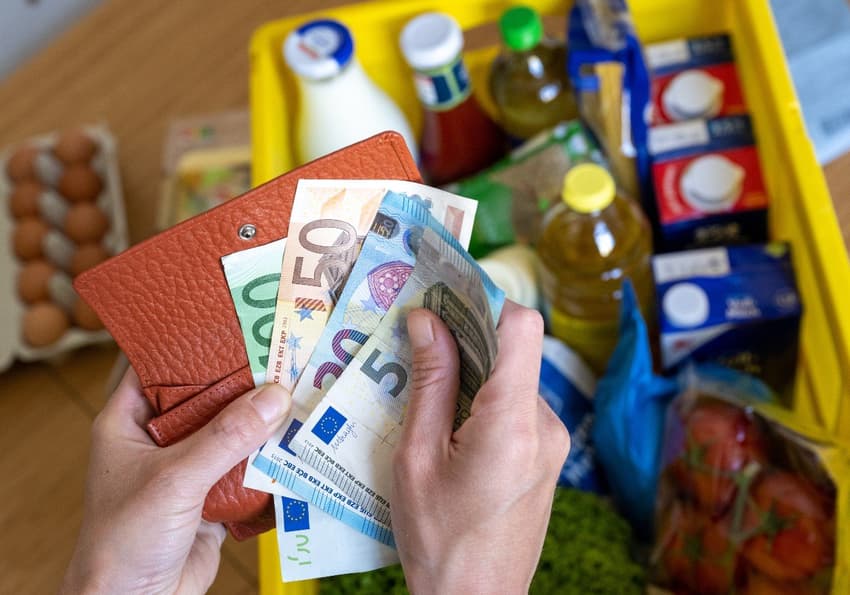German food prices rise 'above average' as inflation remains steady

German inflation held steady at
8.7 percent in February, official data showed Wednesday, as government support
measures help keep the lid on high energy costs.
Germany's annual inflation rate held steady at 8.7 percent, the same level as in January, according to federal statistics agency Destatis.
Food prices showed "above average growth" in February, Destatis said, but energy prices "eased slightly" year-on-year. Particularly affected were fruits and vegetables, with some popular German staples such as cucumbers reaching more than €3 each.
READ ALSO: How much will grocery prices go up in Germany in 2023?
Inflation remains at a high level overall, and well above the European Central Bank's two-percent target.
Price pressures are proving persistent in other leading eurozone economies as well, other data showed this week.
Inflation ticked up in France in February to reach 6.2 percent, fuelled by higher prices for food and services.
Consumer price growth in Spain also inched up for the second straight month, to 6.1 percent.
Eurostat will publish its February inflation data for the 20-nation eurozone on Thursday, after the rate eased to 8.6 percent in January.
Revised calculation
In Germany, Destatis recently revised the way it calculates the inflation rate in Europe's biggest economy, as part of a regular review of the consumer price basket.
The change has made it harder to make direct comparisons with previous months. Under the old calculation, German inflation peaked at 10.4 percent in October.
Using the new method, the October figure stood at a more modest 8.8 percent. The ECB prefers to look at the inflation rate using the Harmonised Index of Consumer Prices (HICP). By that measure, inflation in Germany reached 9.3 percent in February, up from 9.2 percent in January.
Regardless of the different calculations, "we probably left the peak of inflation behind us last autumn", said KfW chief economist Fritzi Koehler-Geib.
Increases in food and energy costs, pushed up by the war in Ukraine, have started to lose momentum in part thanks to massive government interventions.
But prices for goods and services "still have room to rise", Koehler-Geib said, suggesting the ECB should "stay on course" with its rate hikes.
The ECB has lifted interest rates at an unprecedented pace since last July in a bid to cool prices and return inflation to target.
The bank plans to raise rates by another 50 basis points at its next meeting in March. Germany's Bundesbank president Joachim Nagel on Wednesday said the March increase "won't be the last".
READ ALSO: 10 ways to save money on your groceries in Germany
Comments
See Also
Germany's annual inflation rate held steady at 8.7 percent, the same level as in January, according to federal statistics agency Destatis.
Food prices showed "above average growth" in February, Destatis said, but energy prices "eased slightly" year-on-year. Particularly affected were fruits and vegetables, with some popular German staples such as cucumbers reaching more than €3 each.
READ ALSO: How much will grocery prices go up in Germany in 2023?
Inflation remains at a high level overall, and well above the European Central Bank's two-percent target.
Price pressures are proving persistent in other leading eurozone economies as well, other data showed this week.
Inflation ticked up in France in February to reach 6.2 percent, fuelled by higher prices for food and services.
Consumer price growth in Spain also inched up for the second straight month, to 6.1 percent.
Eurostat will publish its February inflation data for the 20-nation eurozone on Thursday, after the rate eased to 8.6 percent in January.
Revised calculation
In Germany, Destatis recently revised the way it calculates the inflation rate in Europe's biggest economy, as part of a regular review of the consumer price basket.
The change has made it harder to make direct comparisons with previous months. Under the old calculation, German inflation peaked at 10.4 percent in October.
Using the new method, the October figure stood at a more modest 8.8 percent. The ECB prefers to look at the inflation rate using the Harmonised Index of Consumer Prices (HICP). By that measure, inflation in Germany reached 9.3 percent in February, up from 9.2 percent in January.
Regardless of the different calculations, "we probably left the peak of inflation behind us last autumn", said KfW chief economist Fritzi Koehler-Geib.
Increases in food and energy costs, pushed up by the war in Ukraine, have started to lose momentum in part thanks to massive government interventions.
But prices for goods and services "still have room to rise", Koehler-Geib said, suggesting the ECB should "stay on course" with its rate hikes.
The ECB has lifted interest rates at an unprecedented pace since last July in a bid to cool prices and return inflation to target.
The bank plans to raise rates by another 50 basis points at its next meeting in March. Germany's Bundesbank president Joachim Nagel on Wednesday said the March increase "won't be the last".
READ ALSO: 10 ways to save money on your groceries in Germany
Join the conversation in our comments section below. Share your own views and experience and if you have a question or suggestion for our journalists then email us at [email protected].
Please keep comments civil, constructive and on topic – and make sure to read our terms of use before getting involved.
Please log in here to leave a comment.